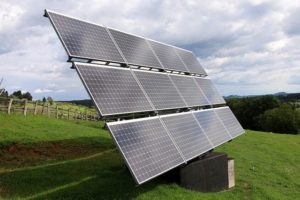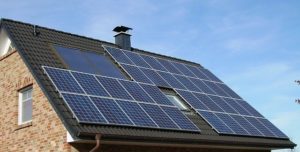 Let’s look at answers to five basic questions about going solar. This information will help you decide whether solar is right for you as a homeowner.
Let’s look at answers to five basic questions about going solar. This information will help you decide whether solar is right for you as a homeowner.
First, what kind of roof do you have? Does your roof get very much sunshine? What’s your electricity bill like? What kind of funding do you need and how can you save the most? And finally… can a single household going solar really help the environment? Our answers will help serve as your home solar guide.
It’s okay if you aren’t quite sure whether home solar is right for you. We can offer you solid science and clear advice to help you make the decision.
- Is Your Roof Right For Solar?
- Does Your Home Get Enough Sun?
- What Are the Costs of Going Solar?
- When Will Solar Save You Money?
- What is the Real Environmental Benefit of Home Solar?
Is Your Roof Right For Solar?
What kind of roof do you have? To be the right match for solar panels, your home’s roof will need to be relatively strong, large, and durable. You’ll have the most success with a roof facing south for maximum sun exposure. It should also be able to hold at least five pounds per square foot for the 25 to 30-year lifespan of your solar panels. Learn more about all of this in our solar roof guide.
If your roof doesn’t match this description, or if you’re not sure whether it does, it doesn’t mean solar isn’t right for you! Roof panels are most common but there are a lot of alternatives, too.
Does Your Home Get Enough Sun?
The build of your roof is important if you are looking at roof-mounted solar panels for your home. But there are a few things you’ll want to consider, including where your home is located. Does your property see a lot of cloudy weather? Is there a lot of shade on your property? If so, will going solar still work for you?
 A lot of direct sun is ideal but if your sunshine isn’t strong every day or all through the year, that might not be as much of a problem as you’d expect. If you can capture lots of energy during peak sun, then you may be able to store your energy in a battery. Batteries used to be rare, appearing in merely 5% of solar installations. But they are expected to become far more popular over the next five years, reaching 25% of solar power systems. Our solar battery guide can help you assess whether batteries may be right for you.
A lot of direct sun is ideal but if your sunshine isn’t strong every day or all through the year, that might not be as much of a problem as you’d expect. If you can capture lots of energy during peak sun, then you may be able to store your energy in a battery. Batteries used to be rare, appearing in merely 5% of solar installations. But they are expected to become far more popular over the next five years, reaching 25% of solar power systems. Our solar battery guide can help you assess whether batteries may be right for you.
Batteries aren’t your only choice for storing excess energy, however. If you can capture more power than you need, you can have solar credits sent to your power grid locally with solar net metering. Credits will save you money later.
Geographical location is also important to consider. If your home is in the United States, you’re located in the northern hemisphere. The sun will shine largely from the south as it follows its orbit. So the direct sunlight your home gets will come mostly from its south side. A roof that faces the south will get maximum sun, and solar panels that are south-facing with give you maximum power. But if your roof doesn’t face south, you might want to consider ground-mounted panels instead. If you have solar panels mounted on the ground you can control their direction and point them south.
What Are the Costs of Going Solar?
The average-sized residential home solar system produces around 5 Kilowatts. The typical cost of that system is around $18,000 in the U.S. But the cost is considerably less after tax credits, varying state-by-state at around $12,000 to $15,000. These numbers are very recent, coming from a 2020 nationwide sample.[1]Solar Energies Industries Association
These costs will pay for themselves in the form of energy bill savings after five to ten years of use. But what if you decide to sell your home before then? A study conducted by UC Berkeley in 2015 has shown that home solar increased home sale prices by $15,000.[2]Lawrence Berkeley National Laboratory Your home solar will pay for itself whether you use it for many years, or whether you sell soon after installation. Homeowners will see that solar is a really sensible investment. But what if you don’t have the budget to cover these upfront costs of going solar?
Incentives and subsidies can help lower your costs. Leases, loans, and PPAs are three important funding options for you to consider. A solar lease is similar to leasing a car. It can be a more affordable way to get into solar. Certain solar loans can also help you get the funding you need. Either solar loans or solar leases are worth looking into if you are concerned about the upfront costs of solar power. You might also want to look into a Solar Purchase Agreement or Community Solar. Those alternative options allow you to use a solar system that is owned by someone else, so you can quickly see energy bill savings and use clean energy with even paying for your own installation or maintenance.
But if you can afford your own home solar system, that will offer you the biggest savings. How can you achieve this goal? Shop smart and educate yourself by comparing installers’ quotes and staying on the low end of the average $12,000 to $15,000 range. Comparing quotes can trim 10% from your installation costs. That’s some of the best advice our home solar guide has to offer.
When Will Solar Save You Money?
Will solar actually save you money? The simple answer is: if your energy bill is $100 or more each month, you will see savings. When exactly you will start to see those savings depends on your situation, but the average installation of home solar pays for itself in five to ten years. From that point on, you will save on your energy bill every month for another 15 to 20 years.
If your house is an average size and needs an average home solar system (about 20 roof panels), then these estimates should be about right. Since solar panel systems last usually around 25 to 30 years, you could see big savings from your system. The bottom line is: solar will save you money, if it works for you to purchase solar installation.
What is the Real Environmental Benefit of Home Solar?
Solar is clean energy, but how big of an environmental impact does it actually make? You are only one homeowner. Can your household’s choices really help the earth’s climate in a big way? There is no single answer for every household, but let’s consider some interesting numbers.
The EPA has stated than the average household in the U.S. emits 7.27 metric tons of C02 annually from the use of electricity. [3]EPA Many areas in the U.S. are powered by electricity from natural gas. Solar’s carbon emissions are only one third or less compared to natural gas.[4]Union of Concerned Scientists So if we crunch those numbers, by using solar your household’s solar panel carbon footprint would be 4.8 metric tons smaller in every year with solar!
Let’s put those numbers in perspective. “Ten Million Trees” says that one mature tree removes around 18 pounds of carbon from the atmosphere every year. [5]Ten Million Trees In that case, switching your home power to solar could instantly do the work of more than 587 trees, each year! The math and science are clear: switching your household to solar really can make a difference.
That is a big part of why solar is growing in popularity. Between 2010 and 2020, the U.S. has seen a massive boom in solar power adoption. Every single year of the past decade has had a growth rate of 49%! Between the notable solar savings and the environmental benefits, our home solar guide shows why many see that going solar is a great home improvement.
Reading up on home solar advice can help you decide whether you’ll be the next homeowner to join the solar movement.

